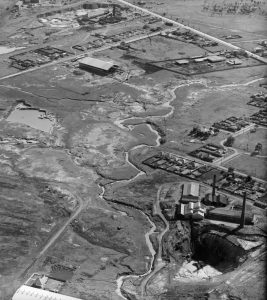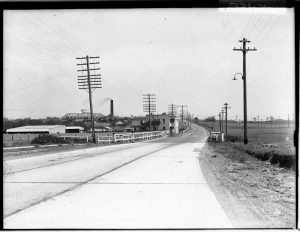Moore’s Bridge

Extract from Cumberland County map showing Moore’s Bridge at Cooks River on the Liverpool Road and Homebush, c.1831. Courtesy State Library of NSW
Have you visited the Cooks River exhibition in the Ironbark Gallery yet?
Early maps mark Moore’s Bridge over the meandering river at Strathfield South (formerly Enfield), constructed in 1814 when Liverpool Road was built by William Roberts. The road was opened by Governor Macquarie.
Philanthropist, Thomas Moore (1762-1840), who gave his name to the bridge, was master boatbuilder to Governor Hunter. In 1799 he received a grant of 470 acres between Petersham and the Cooks River, although he does not appear to have lived in the district, residing on a smaller grant alongside the Tank Stream in Sydney itself. In 1803 he was sent to obtain timber from the Georges River district for naval purposes and in 1804 he oversaw the building of the first seagoing vessel ever launched from a NSW dockyard. It was named Integrity.[1]

Cropped Milton Kent aerial photo of Enfield, 1923 showing the meandering Cooks River. Moore’s Bridge is just out of sight in the top right corner where the river meets Liverpool Road. Courtesy State Library of NSW
Later, Moore settled on his farm Moorebank on the Georges River where he became a local magistrate known as the ‘King of Liverpool’. He purchased further land and became a major landholder and farmer. In 1821 he became a magistrate for NSW.[2] A generous benefactor, he contributed towards the building of churches and schools in the Liverpool district. His funding also helped to build St Andrew’s Cathedral in the city.
Moore died without children in 1840, leaving his house and grounds for the foundation of a college to educate young Protestant men. In 1856 Moore Theological College [3] opened on this site but transferred to Newtown in 1891 to be closer to the University of Sydney. In Moorebank, Lake Moore and Thomas Moore Park also recognise his legacy. Confusingly too, ‘Moore’s Bridge’ also once referred to the bridge across Prospect Creek on Liverpool Road at Lansdowne, named for the same Thomas Moore.
By 1895 the bridge at Strathfield South was in a poor state of repair:
‘The dangerous condition of Moore’s Bridge, Enfield, is to be remedied by the Works Department, and shortly tenders for its repairs are to be called.’[4]
In 1939 Bruce Ryrie Campbell was fined £5 at the Traffic Court for crossing Moore’s Bridge at 60 miles per hour.[5] Shockingly, the police car had to do 70 miles per hour to overtake him.

Moore’s Bridge over Cooks River, Enfield (now Strathfield South), 1939. Courtesy NSW State Archives
Although used for many years, often in defining boundaries, the name ‘Moore’s Bridge’ at Strathfield South gradually fell out of use during the 20th Century. Today, thousands of vehicles pass over the bridge on busy Liverpool Road every day.
The Cooks River: Yesterday, Today and Tomorrow exhibition in the Ironbark Gallery of Strathfield Council Library and Innovation Hub closes on Sunday 11 February. See: https://www.strathfield.nsw.gov.au/event/cooks-river-yesterday-today-and-tomorrow/
By J.J. MacRitchie
Local Studies Advisor
References
[1] HMCS Integrity https://en.wikipedia.org/wiki/HMCS_Integrity_(1804)[2] M. L. Loane, ‘Moore, Thomas (1762–1840)’, Australian Dictionary of Biography, National Centre of Biography, Australian National University, https://adb.anu.edu.au/biography/moore-thomas-2476/text3325, published first in hardcopy 1967, accessed online 31 January 2024.
[3] Moore Theological College https://moore.edu.au/
[4] Evening News 17 June 1895 p.5 https://trove.nla.gov.au/newspaper/article/108088026
[5] The Sun 30 August 1939 p.5 https://trove.nla.gov.au/newspaper/article/231414322
